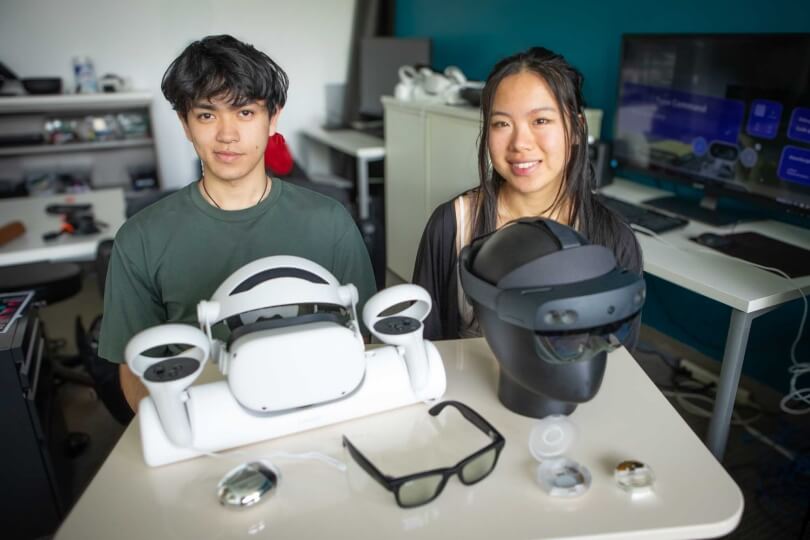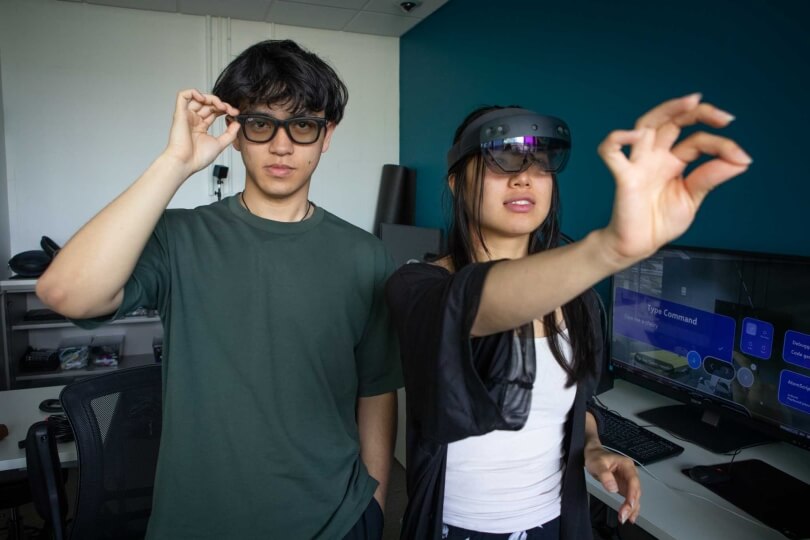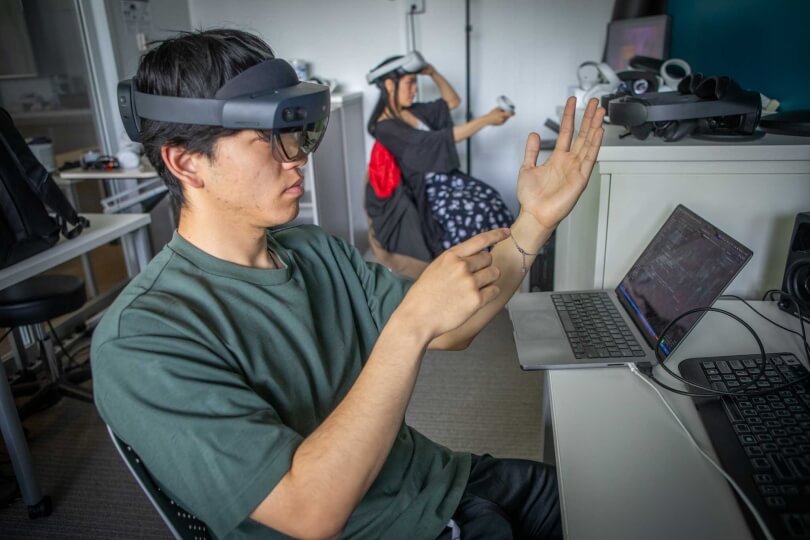AnhPhu Nguyen and Alice Cai, fourth-year special concentrators in human augmentation (Eliza Grinnell/SEAS)
AnhPhu Nguyen and Alice Cai met in the Makerspace in the fall of their freshman year. Cai wanted to 3D print a new case for her iPhone, but wasn’t sure which iPhone she had. Nguyen, having founded an iPhone repair business in his hometown in Nebraska, was the perfect person to ask.
The two soon realized they had far more in common than just iPhones. They both loved to build things, and collaborated on a replica Iron Man helmet. Their collaborations continued to grow from there: they co-founded the AR/VR Developers club, and joined a week-long summer program focused on blockchain development. Around Halloween one year, the AR/VR club teamed up with Conflux, an art-technology fusion club Cai co-founded, to build the “Nervous Network,” pairing heart sensors with virtual reality headsets and LED light strips to create a visual representation of the fear people experience when watching scary movies. During winter session that year, Nguyen helped build an installation for “Liminal Spaces,” Conflux’s inaugural winter residency.
“I really enjoy working together with friends on things,” said Cai, A.B. ‘25. “Organizing residencies was really meaningful to me.”
AnhPhu Nguyen and Alice Cai demonstrate some of the technology they've developed at SEAS (Eliza Grinnell/SEAS)
Alongside their shared extracurricular interests, both seniors also realized the traditional concentrations of the Harvard John A. Paulson School of Engineering and Applied Sciences (SEAS) weren’t quite what they wanted. So instead, they designed a special concentration they called “Human Augmentation.” Their studies drew on a wide range of topics, from computer science and engineering disciplines to the humanities and social sciences. Their advisor is Conor Walsh, Paul A. Maeder Professor of Engineering and Applied Sciences at SEAS.
“You have to get a faculty advisor, and you have to get approval from a department,” Cai said. “You have to put together a statement of purpose for why you want to do a special concentration, and put together a course plan.”
The two came up with their special concentration early in their second year. While Cai was always leaning towards a special concentration of some sort, Nguyen wasn’t quite sure until he cross-registered for a class at MIT.
“We took a virtual reality and brain-computer interface class together, which was very human augmentation-related,” Nguyen said. “We got really into the idea of cyborgs and transhumanism, whether we should merge with computers, and decided that human augmentation would be the best umbrella for our work, a lot of which was geared towards human-computer interaction and merging with machines.”
To get approval for their concentration, the duo split their proposed course load into three main areas: physical augmentation, cognitive augmentation, and environmental augmentation. While these divisions guided the courses they took at first, the pair began to separate as their individual interpretations of human augmentation began to differentiate. Nguyen became more interested in wearable technology, even taking one semester off – he’ll graduate in December – to work at a start-up. Cai, a writer from a young age in Arkansas, became more interested in how technology augments creativity, and how it interacts with larger societal systems.
“After junior year, I became less interested in individual augmentation, and more interested in how we change the systems we live in, because those really constrain what we’re capable of doing and experiencing,” she said. “So now I’m more interested in topics like economics and politics. Towards the latter half of college, I really began to diverge from the courses I’d initially said I’d take, and started to take courses in humanities or at Harvard Divinity School. I don’t think that would’ve been possible without a very flexible concentration.”
Special concentrations also require final projects. While Nguyen won’t have to complete his thesis until next semester, Cai based hers around the experience of growing up in America. She created a longform reflection based on anecdotes from her own life, delving into the ways identity and technology interact.
“If I’m trying to improve something about the human condition, or augment human capability and experience, I first need to understand what I think is problematic,” she said. “I realized there’s almost this sense of ‘liquidity’ to the world, where all social relations, structures and employment all feel very fluid,” she said. But there’s also an increasing complexity of life combined with disintegration of basic ethical interaction. We see a lot of bad things happening, but there’s not a clear pathway for response. There’s also constant technological acceleration, which sometimes makes people feel like they might be left behind by history.”
AnhPhu Nguyen has one semester left until graduation, while Alice Cai Cai will enroll in the information technology program at the MIT Sloan School of Management (Eliza Grinnell/SEAS)
Nguyen plans to build a passive data-collection wearable for his thesis in the fall.
“Using this necklace hardware that I built, I want to design a tool that listens to you all the time, and then helps you improve your conversational skills,” he said. “If it works, it’ll provide real-time interventions for improving your conversations.”
Cai and Nguyen last worked together in the summer of 2024, when Nguyen was a summer resident in the Augmentation Lab, another club Cai co-founded. Both seniors have had other collaborators over the years: Cai with Augmentation Lab co-founder Aida Baradari, a physics and computer science dual-concentrator, or Conflux co-founder Peggy Yin; Nguyen with Caine Ardayfio, a physics concentrator. Nguyen and Adayfio made national headlines by exposing how Meta smart glasses could be used to access private information.
In the fall, Cai will enroll in the information technology program at the MIT Sloan School of Management, a program that combines elements of computer science, sociology and economics to explore how technology can improve social systems.
Wherever they go next, Cai and Nguyen have taken a truly unique path through SEAS, taking on projects and founding clubs that have created new opportunities and infused new ideas about technology and humanity into the SEAS community.
“I’ve learned so much at Harvard, and met so many awesome people,” Nguyen said. “Harvard gives you the freedom to study what you truly care about, and they have so many resources for you to get there. Having the predefined structure of an established concentration can sometimes be valuable, because it can feel a little lonely working for years on pretty out-there stuff that might not work out. But overall, it’s been an amazing journey.”


